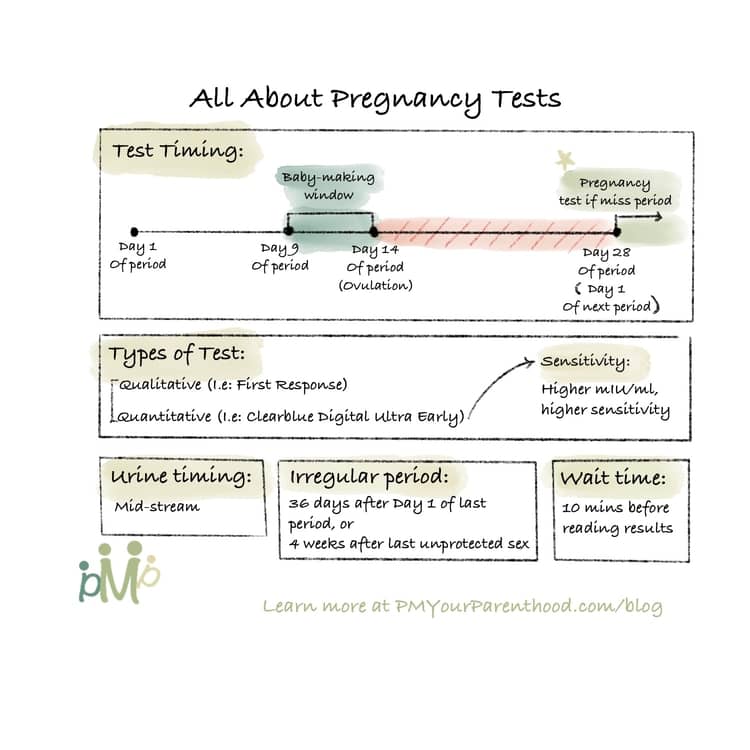
Our takeaways:
- Wait until the day of or after a missed period to do pregnancy test(s) to avoid unnecessary stress due to low(er) accuracy.
- There are two common types of hCG tests: qualitative (i.e: FIRST RESPONSE™) and quantitative (i.e: Clearblue Digital Ultra Early Pregnancy Test).
- Quantitative pregnancy tests use mIU/ml to indicate sensitivity. The lower the number, the more sensitive is the test kit, and the sooner it can tell you’re pregnant.
- Other factors to consider: Irregular menstrual cycle, urine sample timing, wait time, etc.
Assuming you’ve got all the pre-pregnancy stuff figured out, here comes the next challenge: Am I pregnant? Sure, you saw those positive pregnancy sticks (aka. Home Pregnancy Test or HPT) people use to announce their pregnancies on social media all the time, thinking that would be the way to go. But when is the best time to test? how many times do you need to test to be sure? does the HPT accuracy differ by brand? You will have a clearer picture after this 4-min read.
Timing for pregnancy test(s)
Before we get into the best timing for pregnancy test, let’s do a refresher on the baby-making timing in relation to the menstrual cycle:
…the baby-making sex(es) need to happen during Day 9 to Day 14 from the start date of your period
Source: Making a baby? Make sure you get the timing right
In other words, the baby-making happens from 5 days (Day 9) before ovulation through the day of ovulation (Day 14). This leaves us another 14 days/two weeks until the next period (assuming the 28-day period) or when you find out that your period is late (one of the many signs that you might be pregnant). So the question comes to: Do I test during this two-week window or AFTER I find out that my period is late?
To answer this question, we need to understand what happens after the baby-making. We know that fertilized eggs without implantation won’t result in pregnancy. In lay terms, only having sperm meet the egg won’t be enough – the fertilized egg needs to then travel to the uterus to kick off the implantation process when hCG (Human Chorionic gonadotropin, a pregnancy-specific hormone) CAN BE detected in urine and bloodstream by the testing kits. On average, the implantation happens 6 to 12 days after fertilization. So IN THEORY, you could test positive a week before your next period if you’ve conceived (within the two-week window).
However, as you might have noticed, “6-12 days” is quite a big range. Moreover, at the beginning of implantation, hCG might be too little for the test to pick up. So it is likely that you will get false negatives during this period, which can be frustrating and stressful.
Although some testing kits claim that you can test 4-5 days before your expected period, the accuracy ranges from 60% to 75%. To me, this accuracy is still too low to be worth trying (Think about all that excitements and disappointments). Not to mention that pregnancy loss is also common during this period.
To conclude, I’d wait until the day of or after my missed period to test in order to avoid unnecessary stress due to low(er) accuracy.
Other factors to consider for better accuracy
Of course, there are other worth-noting factors that might impact the accuracy of pregnancy tests.
Pregnancy test sensitivity
There are two common types of hCG tests. A qualitative test detects if hCG is present in the blood (i.e: FIRST RESPONSE™ Pregnancy Test Strips. Source). A quantitative test (or beta) measures the amount of hCG actually present in the blood. Quantitative pregnancy tests use mIU/ml (Milli-International Units per Milliliter) to measure hCG and you can find this info on the packages (i.e: Clearblue Digital Ultra Early Pregnancy Test has a sensitivity of 10 mIU/ml. Source). The lower the number, the more sensitive is the test kit, and the sooner it can tell you’re pregnant.
Irregular menstrual cycle
Irregular menstrual cycle makes it more difficult to time the pregnancy test(s) because you simply don’t know whether your period is late or not. I found this info provided by US Department of Health & Human Services helpful (Source):
“If you have irregular periods, try counting 36 days from the start of your last menstrual cycle or four weeks from the time you had sex. At this point, if you are pregnant, your levels of hCG should be high enough to detect the pregnancy.
If your test says you are not pregnant, but you still think you may be pregnant, wait a few more days and take another pregnancy test. Or, call your doctor for a blood test.”
Urine sample timing
According to US Department of Health & Human Services, testing your urine first thing in the morning can boost accuracy. However, per What to Expect When You’re Expecting (5th Edition), any-time-of-the-day pee will do. It does mention that most tests would recommend use mid-stream urine, meaning you would need to start peeing for 1s or 2s, stop, and then catch the rest of the stream.
Wait time & others
Although this might differ from brand to brand (make sure you read the instructions), wait up to 10 minutes after taking the test to check the results. Research suggests that waiting 10 minutes will give the most accurate result. Also, make sure to check the expiration date of your testing kits.
Like this article? Share it with your loved ones! To get bite-size parenthood wisdom like this, or save infographics for future references, follow us on Instagram (@PMYourParenthood)!
Also you can support me and my work by contributing a cup of coffee here:


